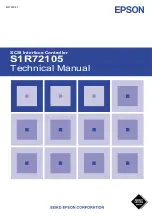
REMOTE SETPOINT OPTION
A remote 0/4 to 20 mA analog input signal can be used to change the
setpoint value. This input can be scaled over a process range independent of
that of the system range. In operation, the front panel “MN” indicator
illuminates for local setpoint operation and is off for remote setpoint
operation. In either mode, the indicator flashes during Manual Mode.
Filtering, ramp rate (velocity limiting), and local/remote transfer response
options can be configured to suit the application. Local/Remote transfer
operations are performed either externally (user input) or at the keypad.
If large changes in the remote setpoint signal result in undesirable
controller performance, the remote setpoint can be velocity limited (ramped)
by the setpoint ramp parameter (SPrP).
Similarly, if fluctuation in the remote setpoint signal also results in poor
performance, the programmable filter can be used to provide a steady setpoint
to the controller. A unique feature of the filter is the filter band. Fluctuations
that occur that are less than the filter band value keep the filter engaged, while
fluctuations outside the filter band disable the filter. This action allows the
controller to respond rapidly to large changes of the remote setpoint signal.
CASCADE CONTROL
External cascade control involves the use of two controllers, one of which
has a Remote Setpoint Input.
The outer loop controller (Primary controller) directs the setpoint of the
inner loop controller (secondary controller) through the linear DC output.
The secondary controller has a Remote Setpoint option in order to receive the
directed setpoint. See Figure 34, Cascade Control, for more details.
Note: The Remote Setpoint of the secondary controller must be scaled prior to
tuning the controllers. Normally, the Remote Setpoint is scaled to equal the
actual process range of the secondary. Scaled in this way, the primary
controller can direct the setpoint of the secondary controller over its
operating range. Normally, the secondary controller is a faster control loop.
It is able to respond quickly to disturbances before they affect the primary
loop. Therefore, the control quality of the primary loop under cascade control
is superior to that of a single loop controller.
-56-
Figure 34, Cascade Control
Содержание CN63100 Series
Страница 23: ...FRONT PANEL PROGRAMMING CHART FOR CN63100 CN63300 CONTROLLERS 15 ...
Страница 48: ... 40 ...
Страница 62: ...PID Adjustments Cont d 54 Figure 33 Process Response Extremes ...
Страница 88: ... 80 ...
Страница 89: ... 81 ...
Страница 90: ... 82 ...
















































